A common problem is to find the largest or smallest
value of something, usually subject to certain conditions. The
"something" will be modelled by a function ![]() ; here is a precise definition of what I mean by
"largest" and "smallest".
; here is a precise definition of what I mean by
"largest" and "smallest".
Suppose c is a point in the domain of a function ![]() . Then:
. Then:
1. An absolute maximum occurs at c if ![]() for all x in the domain of f.
for all x in the domain of f.
2. An absolute minimum occurs at c if ![]() for all x in the domain of f.
for all x in the domain of f.
Sometimes it's important to consider points which are only largest or smallest in small parts of a graph.
1. A relative (or
local) maximum occurs at c if ![]() for all x in an open interval containing c.
for all x in an open interval containing c.
2. A relative (or
local) minimum occurs at c if ![]() for all x in an open interval containing c.
for all x in an open interval containing c.
If a local max is like being the toughest guy on your block, an absolute max is like being the toughest guy in the world.
Local maxima and minima are important in graphing functions, among other things. However, today I'll concentrate on absolute maxima and minima. I'll begin by looking at some pictorial examples.
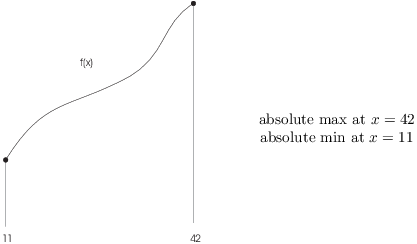
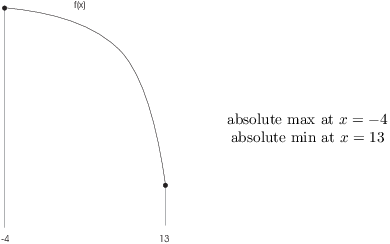
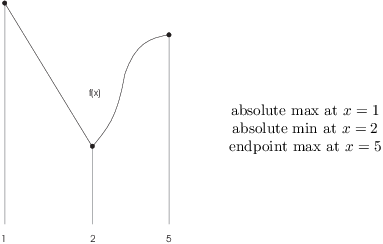

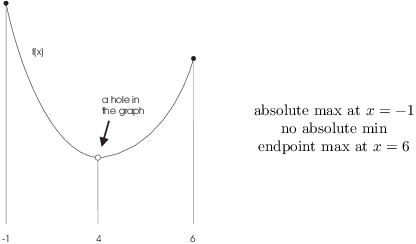
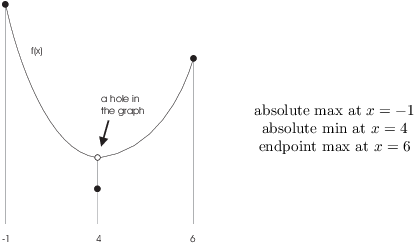
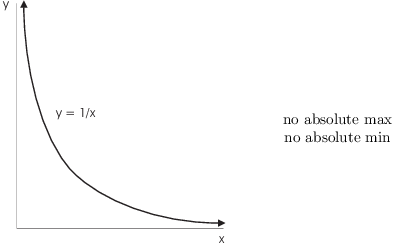

Some conclusions may be drawn from these examples:
(a) A function need not have an absolute max or absolute min. It can have both, one or the other, or neither.
(b) A continuous function must have an absolute max and an absolute min on a closed interval.
The second observation is important: It says that if you look for an absolute max or min on a closed interval, at least in principle you won't be disappointed. The proof requires more advanced knowledge about the topology of the real numbers, so I'll omit it.
Where can you expect an absolute max or min to occur? Here's a reasonable guess based on the examples above. I'll assume that I'm looking at a function that is continuous on a closed interval, so the secon observation guarantees that I have an absolute max and an absolute min.
Theorem. For a continuous function on a closed interval, an absolute max or min can occur at:
1. A critical point for ![]() --- that is, a value c in the domain of f where
--- that is, a value c in the domain of f where ![]() is undefined or
is undefined or ![]() .
.
2. An endpoint of the interval.
Proof. I'll give a sketch of the proof of this
result. Assume that f is continuous on an interval ![]() and differentiable on
and differentiable on ![]() .
.
Suppose that c is a max or a min, but c is not an endpoint (a or b)
or a place where ![]() is undefined. I'll show that
is undefined. I'll show that ![]() .
.
If ![]() , then it's either positive or negative.
Assume
, then it's either positive or negative.
Assume ![]() --- the argument if
--- the argument if ![]() is similar.
is similar.
Recall that
![]()
This means that
![]()
Another way of saying this is that I can make ![]() as small as I want
by making x sufficiently close to c. So make x close enough to c so
that
as small as I want
by making x sufficiently close to c. So make x close enough to c so
that
![]()
Writing this absolute value inequality as a pair of inequalities, I have

I got the second set of inequalities by adding ![]() to each term of the first.
to each term of the first.
Now ![]() , so the last set of inequalities has
, so the last set of inequalities has ![]() caught between two positive
numbers. Therefore,
caught between two positive
numbers. Therefore, ![]() must be positive. Therefore, the top and bottom of this fraction are
either both positive or both negative.
must be positive. Therefore, the top and bottom of this fraction are
either both positive or both negative.
If ![]() --- that is, x is to the right of c --- then
--- that is, x is to the right of c --- then ![]() is positive, so
is positive, so ![]() , and
, and
![]() . In other words, the function f increases
as you move from c to the right. Since there are bigger
values of f to the right of c, it means that c can't be a max.
. In other words, the function f increases
as you move from c to the right. Since there are bigger
values of f to the right of c, it means that c can't be a max.
If ![]() --- that is, x is to the left of c --- then
--- that is, x is to the left of c --- then ![]() is negative, so
is negative, so ![]() , and
, and
![]() . In other words, the function f decreases
as you move from c to the left. Since there are smaller
values of f to the left of c, it means that c can't be a min.
. In other words, the function f decreases
as you move from c to the left. Since there are smaller
values of f to the left of c, it means that c can't be a min.
But now I'm stuck, because I assumed that c was either a max or a min.
The only possibility is that my assumption that ![]() was incorrect. So indeed,
was incorrect. So indeed, ![]() .
.![]()
This leads to the following procedure for finding the absolute max or
min of a function ![]() on a closed interval
on a closed interval ![]() :
:
1. Locate the critical points of f which lie in the interval.
2. Plug the critical points and the endpoints of the interval into f.
3. The largest values of f correspond to the absolute maxima; the smallest values of f correspond to the absolute minima.
(A remark for people who know some calculus: Do not confuse this with
the First or Second Derivative test! You plug the candidate points
into ![]() , not into
, not into ![]() or
or ![]() .)
.)
Example. Find the absolute max and absolute
min of ![]() for:
for:
(a) ![]() .
.
(b) ![]() .
.
(c) ![]() .
.
(a) First, I'll find the critical points. ![]() , so
, so ![]() for
for ![]() . Note that
. Note that ![]() lies in the interval
lies in the interval ![]() . There are no values of x for which f is
undefined.
. There are no values of x for which f is
undefined.
The endpoints are ![]() and
and ![]() .
.
I plug ![]() ,
, ![]() , and
, and ![]() into
into ![]() :
:

(b) For ![]() ,
, ![]() is the only critical point, and it's in the interval
is the only critical point, and it's in the interval
![]() .
.
The endpoints are ![]() and
and ![]() .
.

Here is a case where two points are "tied" for absolute max.
(c) For ![]() ,
, ![]() is a critical point, but it is not in the
interval
is a critical point, but it is not in the
interval ![]() . Therefore, it doesn't count.
. Therefore, it doesn't count.
The endpoints are ![]() and
and ![]() .
.

Let me repeat the warning, since it sometimes trips people up: If a critical point is not in the interval under consideration, it is not tested.
Finally, notice that I used the same function ![]() in these three examples, but the answers were
different. The interval under consideration is important ---
it determines which critical points are to be tested, and it
contributes its endpoints as candidates.
in these three examples, but the answers were
different. The interval under consideration is important ---
it determines which critical points are to be tested, and it
contributes its endpoints as candidates.![]()
Example. Find the absolute maximum and
absolute minimum of ![]() on the
interval
on the
interval ![]() .
.
The derivative is
![]()
It's a good idea to write the derivative in factored form, since this makes it easier to read off the critical points.
![]() for
for ![]() and
and ![]() .
. ![]() is defined for all x. The only
critical point in the interval
is defined for all x. The only
critical point in the interval ![]() is
is ![]() . I test the critical point and the endpoints by
plugging them into f:
. I test the critical point and the endpoints by
plugging them into f:

The absolute min is -110 and it occurs at ![]() ; the absolute max is 2 and it occurs at
; the absolute max is 2 and it occurs at ![]() .
.![]()
Example. Find the largest and smallest values of
![]()
I'll do the easy part first: The endpoints are ![]() and
and ![]() .
.
Next, I'll find the critical points. Compute the derivative:
![]()
I would like to simplify ![]() so that I can read
off the critical points. The idea is to get it to look like one
chunk, with everything factored. You can often accomplish this
by:
so that I can read
off the critical points. The idea is to get it to look like one
chunk, with everything factored. You can often accomplish this
by:
(a) Writing negative powers as fractions.
(b) Combining fractions over common denominators.
(Some people prefer negative powers, but I think fractions are more visual and easier to work with.)
So
![]()
There is nothing to factor, so I'm done.
![]() for
for ![]() . And
. And ![]() is undefined for
is undefined for ![]() (because
(because ![]() would cause division by zero.) Not so fast! --- Is f
defined at
would cause division by zero.) Not so fast! --- Is f
defined at ![]() ? Checking the original equation, I see
that
? Checking the original equation, I see
that ![]() . Since
. Since ![]() is undefined at
is undefined at ![]() but f is defined at
but f is defined at ![]() ,
, ![]() is a critical point.
is a critical point.
Note also that both 0 and 3 are in the interval ![]() .
.
You can see the critical points and the endpoints in the graph of the
function. Notice that there is a "corner" at ![]() , where the derivative is undefined.
, where the derivative is undefined.
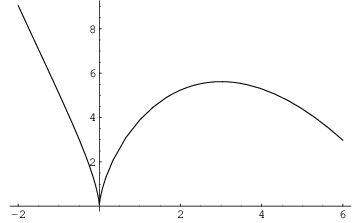
Now I plug the critical pints and the endpoints into f:

Notice that if I'd forgotten to check for places where ![]() is undefined, I would have missed the absolute
min!
is undefined, I would have missed the absolute
min!![]()
Example. Find the largest and smallest values of
![]()
The endpoints are -2 and 8.
The derivative is
![]()
I write the negative power as a fraction, combine fractions over a common denominator, then factor:
![]()
![]() for
for ![]() and for
and for ![]() .
. ![]() is undefined at
is undefined at ![]() ; since
; since ![]() is defined,
is defined, ![]() is a critical point. Since -1, 0, and 1 are in the
interval
is a critical point. Since -1, 0, and 1 are in the
interval ![]() , all of them must be tested.
, all of them must be tested.

The absolute max is at ![]() and the absolute min is at
and the absolute min is at
![]() .
.![]()
Example. Let ![]() . Find the absolute max and the absolute min of f on
the interval
. Find the absolute max and the absolute min of f on
the interval ![]() .
.
Note that
![]()
So
![]()
![]() for
for ![]() and
and ![]() , but only
, but only ![]() is in the interval
is in the interval ![]() . While
. While ![]() is undefined at
is undefined at ![]() , this is not a critical point since
, this is not a critical point since ![]() is undefined --- and in any case, it is not in the
interval
is undefined --- and in any case, it is not in the
interval ![]() .
.

Copyright 2018 by Bruce Ikenaga